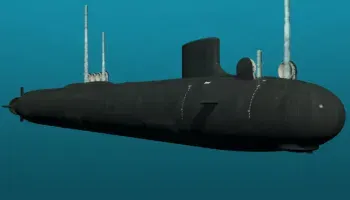
The tradition of US Navy undersea dominance, however, can be traced back decades to the 1950s
The tradition of US Navy undersea dominance, however, can be traced back decades to the 1950s

By Kris Osborn, President, Warrior
(Washington DC)The US Navy is widely regarded for its global undersea superiority, a distinction which the service is intensely working to preserve through extensive modernization and submarine production. Today’s advanced Virginia-class submarines incorporate a Large Aperture Bow sonar array, fly-by-wire computer automated navigation, fiber optic communications and a growing ability to launch and recover undersea drones.
These submarines, which now also include cutting edge coating materials and engine-quieting technologies, have emerged from a long and successful legacy of US Navy submarines. Of course the Virginia-class submarines were preceded by the famous Los Angeles class boats, many of which are still in service. The tradition of US Navy undersea dominance, however, can be traced back decades to the 1950s and the SkipJack-class submarines which preceded the Los Angeles class. The SkipJacks, which emerged in the 1950s and 1960s, pioneered the use of ground-breaking undersea warfare technology which still persists today, as they were among the first submarines to introduce advanced nuclear power and a configuration known as a teardrop hull design. The SkipJacks S5W nuclear reactor laid the foundation for the Los Angeles class’ S6G reactor which emerged in the 1970s. The S5W nuclear reactors allowed the boats to stay underwater for longer periods of time, something which reduced the need for surface handling.
Breakthrough TearDrop Design
The teardrop hull design was considered both pioneering and breakthrough because it advanced undersea maneuverability and performance well beyond the preceding Skate-class submarines. The new SkipJack class boats designed the hull of a submarine to look like a streamlined “blimp” to optimize its performance for undersea speed and maneuverability.
Subsequent submarines such as the Los Angeles and Virginia boats all extended this basic configuration, a design which measurably improved undersea performance. Certainly a smoother undersea hull would direct surrounding waterflow in a streamlined manner to increase speed, yet a smooth exterior shape also likely made submarines quieter and more difficult to detect. Similar to electromagnetic “pings” which bounce off land and air objects using radar, acoustic vibrations send sound-waves to, in a similar manner, bounce off shapes to deliver a return rendering. A smoother underneath shape might therefore make it more difficult for enemy sonar to receive a clear return picture.
The SkipJacks new teardrop design was indeed quite effective, as the boats became known as the fastest in the world until the 1970s arrival of the Los Angeles class. After service in the Vietnam War and supporting US efforts during the Cold War, the SkipJack-class submarines were retired from service by the early 1990s. The boats were also fairly well armed with Mark 14 and Mark 16 torpedoes and a Mark 37 anti-submarine homing torpedo. At the dawn of the nuclear era, the SkipJacks also operated with nuclear-capable Mark 45 torpedoes and the advanced Mark 48 for high value undersea and surface targets.
Future Breakthroughs
Breakthrough designs such as the teardrop hull seem to have been paradigm changing for the future of US Navy submarines, as they continue to inform and inspire submarine designs surging into the future. It seems likely that newer submarines such as Virginia-class Block VI and SSN(X) will incorporate advanced applications of a teardrop hull as well. The essential strategy to optimize speed and undersea maneuverability with a smooth, rounded hull seems to have remained very much intact, and it is likely something which can be continuously improved upon with new coating materials and building strategies. For example, all Block III and beyond Virginia-class submarines have been engineered with additional coating materials engineered to increase undersea stealth and make the boat much harder to detect by enemy sonar. Much like radar absorbent materials used on stealth fighter jets and bombers, certain specialized coating materials can make it much more difficult for an enemy sonar ping to “bounce-off” and deliver a return picture.
Osborn is President of Warrior Maven – Center for Military Modernization. Osborn previously served at the Pentagon as a Highly Qualified Expert with the Office of the Assistant Secretary of the Army—Acquisition, Logistics & Technology. Osborn has also worked as an anchor and on-air military specialist at national TV networks. He has appeared as a guest military expert on Fox News, MSNBC, The Military Channel, and The History Channel. He also has a Masters Degree in Comparative Literature from Columbia University.
